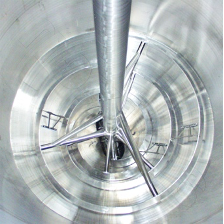
Homogenizer
In industries that process liquid substances, such as dairy processing, the cosmetics industry, or the paint and coatings industry, the term "homogenizing, homogenizer" has a special meaning that goes beyond the simple mixing process. Untreated milk is one such example. The cream floats up, the aqueous phase is at the bottom. A homogenizer is designed to homogenize immiscible components such as water and fat. However, this is only possible if the fat droplets can be made small enough to emulsify in the water. Many of the machines used for this purpose have their origins in solids comminution technology. These are high-speed rotating rotor-stator systems or colloid mills. - In other words, homogenizers that convert particle collectives into a state of homogeneous particle size distribution.-
However, high-pressure pumps can also be used to generate extremely high shear stresses in a liquid in order to produce so-called "water-in-fat emulsions" or "fat-in-water emulsions". The emulsions produced in this way can later segregate again as the fat phase separates from the water phase. Emulsifiers can be used to stabilize emulsions. For example, sunscreen is a water-in-fat emulsion that remains stable for a long time. Possible emulsifiers include lecithins, surfactants or soaps.
Methods of homogenizing: Deagglomeration / Emulsification
One can try to make an analogy between mixing solids and mixing liquids:
If a powder is in the form of extremely small particles, the small particles want to agglomerate. The interparticle forces, especially the Van der Waal forces, act more strongly the smaller the particles are. If such a bulk material is to be homogeneously mixed with other powders, their agglomerates must first be separated into primary particles. Such deagglomeration can take place in suitable powder mixers, if the mixer is equipped with high-speed shear tools and sufficient drive power is available. Renewed agglomeration of the previously separated primary particles can be prevented by the use of so-called flow or trickling aids. These are lightweight powders with particle sizes in the nanometer range and extremely large specific surfaces. These substances distribute well in the mix. They improve the flow behavior of the powders by coating almost all particles. As a result, they make undesirable agglomeration more difficult.
The emulsifier in the liquid mixture acts in a similar way to the flow aid in the bulk mixture.
Annotation:
Apparatus for the treatment of liquids are usually only suitable for liquids. Powders cannot be processed with them. The situation is different for machines that process, homogenize powdery solids:
In solid mixers/homogenizers, liquid materials can often also be processed. This is even often the case when the consistency of a mixed material changes during mixing. As an example, let's consider the vacuum mixed drying of a slurry.
Here, stab-resistant, slurry-like material (suspension from a chamber filter press) is fed into the mixer-dryer. The mixing process re-suspends the wet powders and makes them low viscosity. During vacuum drying, more and more liquid escapes. The mix becomes highly viscous and viscoplastic. Lumps and clods are formed, which are crushed by knife mills and cutting rotors. The drier the mix becomes, the smaller the lumps become. Finally, the agglomerates formed break up. In the dry state, a homogeneous, deagglomerated powder is present. During drying, the mix is homogenized. This process pattern is found in the food industry, chemical industry, advanced ceramics and pharmaceutical industry. In this sense, vacuum mix dryers are also homogenizers or homogenizers.
